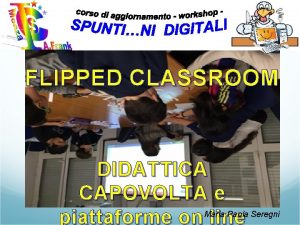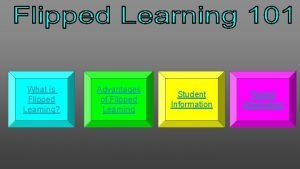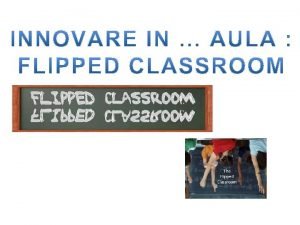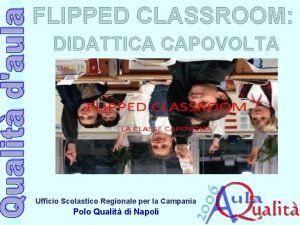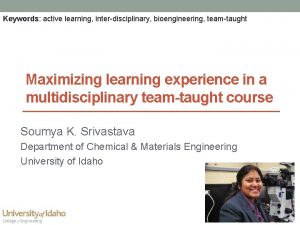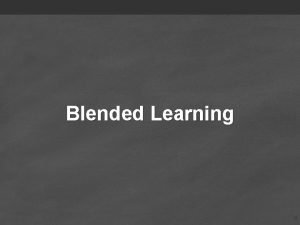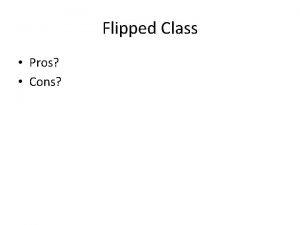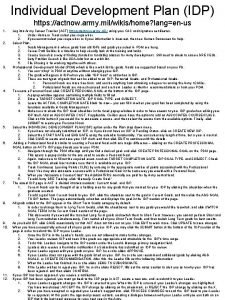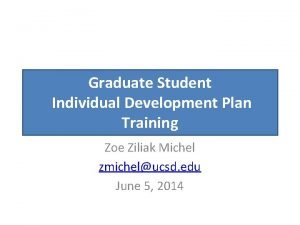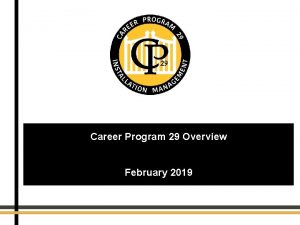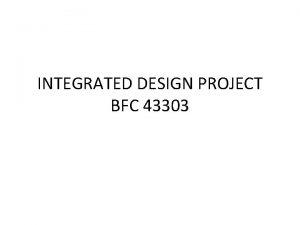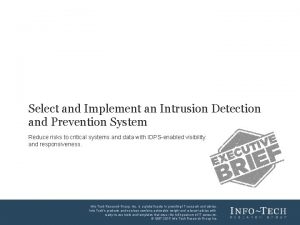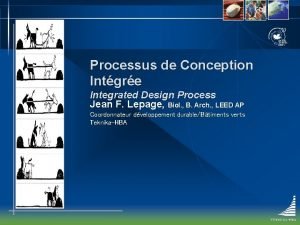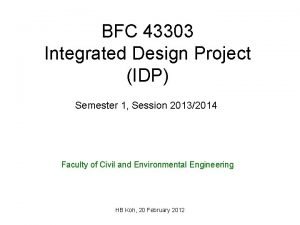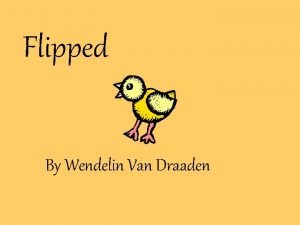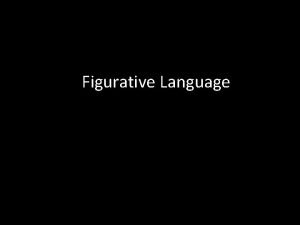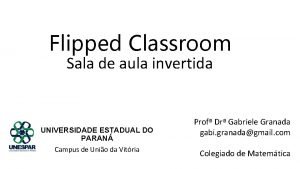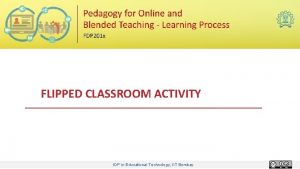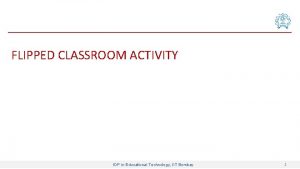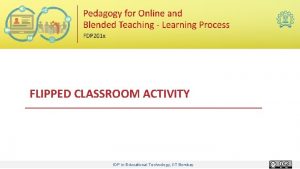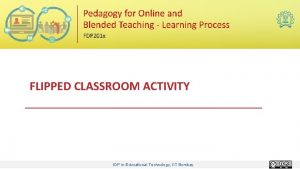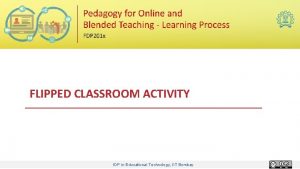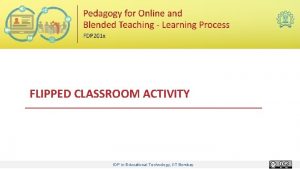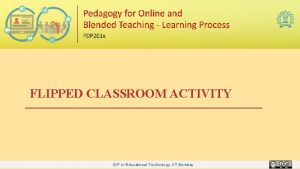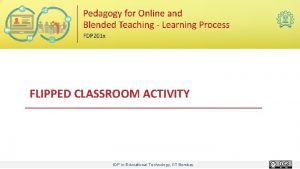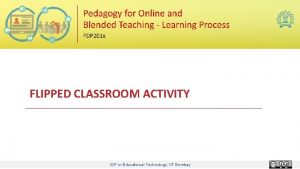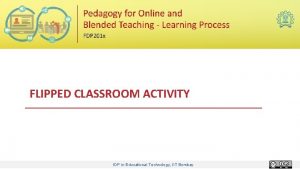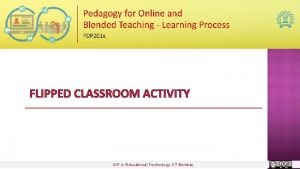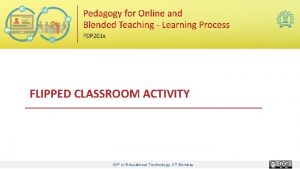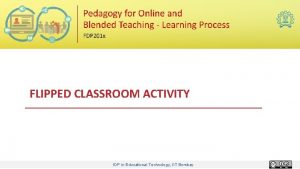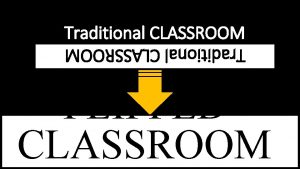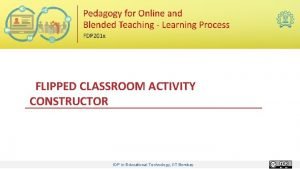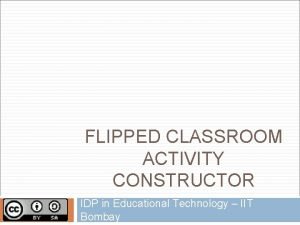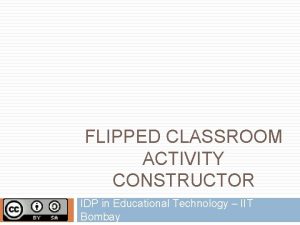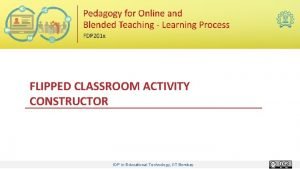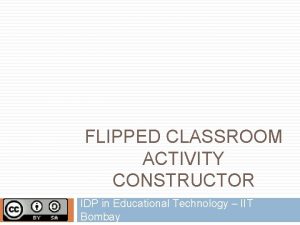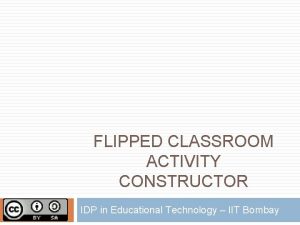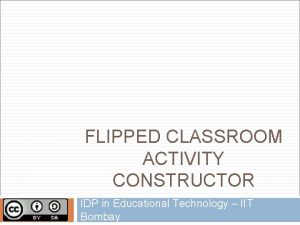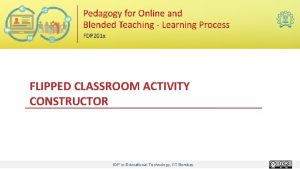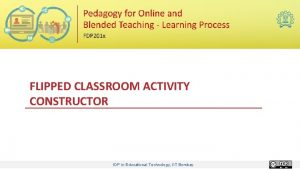FLIPPED CLASSROOM ACTIVITY IDP in Educational Technology IIT




























- Slides: 28

FLIPPED CLASSROOM ACTIVITY IDP in Educational Technology, IIT Bombay

Table of Contents SECTION SLIDE # ABOUT. . . 3 OUT-OF-CLASS SEGMENT IN-CLASS SEGMENT 5 16 IDP in Educational Technology, IIT Bombay 2

About …. . Name of the Teacher : Lavanya Chava Designation : Associate Professor Name of the Department : Civil Engineering Name of the Institute : GRIET Topic : Compaction of soils https: //lavanyachava. wordpress. com/ RC: 1080 RC URL: https: //rc 1080 griet. wordpress. com/ IDP in Educational Technology, IIT Bombay 3

Lavanya Chava Compaction of soils Geotechnical Engineering Civil Engineering B. Tech III Year Students GRIET, Hyderabad IDP in Educational Technology, IIT Bombay 4

Out-of-class Segment This section is for out-of-class segment of Flipped Classroom Strategy. IDP in Educational Technology, IIT Bombay 5

About Out-of-Class Segment § § This is mainly used for Information-Transmission to student. Mostly help to achieve lower-order cognitive levels (Recall-Understand-Apply) It took some time about 3 hrs to search and locate videos. This Out-of-Class activity is about 1 lecture hour IDP in Educational Technology, IIT Bombay 6

Out-of-class Activity Design -1 Learning Objective(s) of Out-of-Class Activity At the end of watching the video students will be able to Differentiate between various accessories required for laboratory method of compaction (Understand Level) § Illustrate the process of laboratory method for standard and modified compaction (Apply Level) § Assess the process of compaction in laboratory using different methods. (Apply Level) § Key Concept(s) to be covered § § § Accessories of compaction apparatus. Procedure for compaction in the laboratory. Difference between standard and modified compaction. IDP in Educational Technology, IIT Bombay 7

Guidelines for Video Selection - 1 § First check in National Repositories • • § NPTEL Videos (http: //www. nptelvideos. in/) NPTEL Youtube Channel (https: //www. youtube. com/user/nptelhrd) Second Look in International Repositories • • • OER Commons (https: //www. oercommons. org/) OCW Consortium (http: //www. oeconsortium. org/) Open Learing Initiative (http: //oli. cmu. edu/) IDP in Educational Technology, IIT Bombay 8

Guidelines for Video Selection - 1 § Third Look in Internet Video Repositories (filter for Creative Commons License) • • Youtube (https: //www. youtube. com) Vimeo (https: //vimeo. com/) Please note that Repository List is not exclusive and there are many more in the web. Please check this link from Edutopia for more information. IDP in Educational Technology, IIT Bombay 9

Video Selection The length of video selected was not more than 10 minutes. § This is because it has been found that shorter videos are more engaging. § The video selected have text narration also. This will help in assimilation of content easier. § Topic Related URLs § http: //nptel. ac. in/courses/105103097/51 § https: //www. youtube. com/watch? v=yl. Lk 5 Ks. UQQc IDP in Educational Technology, IIT Bombay 10

Out-of-class Activity Design - 2 https: //www. youtube. com/watch? v=yl. Lk 5 Ks. UQQc Main Video Source URL Youtube - Reuse allowed License of Video Mapping Concept to Video Source CONCEPT VIDEO SEGMENT DURATION (in min) Accessories V 1 - 0. 00 – 0. 53 Standard compaction V 2 - 0. 53 – 7. 55 7. 02 Modified compaction V 3 - 7. 55 – 8: 15 0. 20 TOTAL DURATION 8: 15 minutes IDP in Educational Technology, IIT Bombay 11

Designing Assessments § § § Few assessments were provided with each video resource. These assessments are at lower cognitive levels (Recall - Understand - Apply), aligned to the learning objectives. Also, these assessments are evaluated before the in-class to understand the level of students. IDP in Educational Technology, IIT Bombay 12

Out-of-class Activity Design - 3 Aligning Assessment with Learning Objective 1 Learning Objective Assessment Strategy Expected duration (in min) Differentiate between various Q 1. Indicate the accessories required various accessories 2 minutes for laboratory for compaction test method of compaction Additional Instructions (if any) Watch V 1 and then answer Q 1 (3 marks for submitting assignment and attendance will be marked only if this submission is completed in time. ) IDP in Educational Technology, IIT Bombay 13

Out-of-class Activity Design - 3 Aligning Assessment with Learning Objective 2 Learning Objective Illustrate the process of laboratory method for standard and modified compaction Assessment Strategy Q 1. Explain the procedure for compaction. Expected duration (in min) Additional Instructions (if any) 5 minutes Watch V 2 and then answer Q 1 (3 marks for submitting assignment and attendance will be marked only if this submission is completed in time. ) IDP in Educational Technology, IIT Bombay 14

Out-of-class Activity Design - 3 Aligning Assessment with Learning Objective 3 Learning Objective Assessment Strategy Assess the process Interpret between of compaction in standard and laboratory using modified different methods compaction Expected duration (in min) 3 minutes Additional Instructions (if any) Watch V 3 and then answer Q 1 (3 marks for submitting assignment and attendance will be marked only if this submission is completed in time. ) Total activity duration – 10 Minutes IDP in Educational Technology, IIT Bombay 15

In-class Segment This section is for in-class segment of Flipped Classroom Strategy. IDP in Educational Technology, IIT Bombay 16

About In-Class Segment § § In the In-Class segment, the activities for effective learning are Ø In active learning student goes beyond listening, copying of notes. Ø Execution of prescribed procedures. Ø Students are required to talk, write, reflect and express their thinking. Designed activity is given to engage students in higher-order thinking (Analyze. Evaluate-Create). Students get feedback on their work, from peers and/or me. Summary provide connectivity of Out-of-Class and In-Class activities. IDP in Educational Technology, IIT Bombay 17

In-class Activity Design -1 Learning Objective(s) of In - Class Activity At the end of the class, students will be able to, § § Determine the dry density of soil (ANALYZE Level) Experiment the soil for compaction (ANALYZE Level) Key Concept(s) to be covered § § Maximum dry density Optimum moisture content IDP in Educational Technology, IIT Bombay 18

In-class Activity Design -2 Active Learning activity(ies) that you plan to do 1. Think pair share (Slide No. 20 -27) 2. Peer instruction (Slide No. 20 -27) Explain the strategy by giving details of 1. What Teacher will do? (Slide No. 21 -22) 2. What Student will do? (Slide No. 23) Justify why the above is an active learning strategy 1. Justification (Slide No. 28) IDP in Educational Technology, IIT Bombay 19

In-class Activity Design -2 Active Learning activities that are planned Real time problem solving using. § Think-Pair-Share Concept clarification using. § Peer Instruction IDP in Educational Technology, IIT Bombay 20

In-class Activity Design -2 Peer Instruction Strategy – What Teacher Does PI questions at the start of the class and provide summary of basic characteristics of soil. Q 1: The process of compaction of a soil involves in a) expulsion of pore water. b) expulsion of pore air. c) expulsion of both pore air and pore water. d) none of the above. IDP in Educational Technology, IIT Bombay 21

In-class Activity Design -2 Peer Instruction Strategy – What Teacher Does Q 2: Which of the expression is correct to determine the dry density? a) d= b/(1+w) b) b= d/(1+w) c) d= b/(1 -w) d) b= d/(1 -w) IDP in Educational Technology, IIT Bombay 22

In-class Activity Design -2 Peer Instruction Strategy – What Student Does § § § For each question they will first choose the correct option individually. Then they will discuss with peers and come to consent. Listen to instructors explanation. IDP in Educational Technology, IIT Bombay 23

In-class Activity Design -2 TPS Strategy – What Instructor does First provide a basis idea on dry density and water content. Compaction of soil is defined as the process by which the soil particles are rearranged and packed together into a state of closer contact to decrease its porosity and thereby increase its dry density. The process of compaction is by the expulsion of air only. In practice, soils of medium cohesion are compacted by means of rolling, while cohesionless soils are most effectively compacted by vibration. Compaction increases the dry density of the soil, thus increasing its shear strength and bearing capacity through an increase in frictional characteristics. IDP in Educational Technology, IIT Bombay 24

In-class Activity Design -2 TPS Strategy – What Instructor does Think ( 2 minutes) Instruction: Assuming the different values of dry density and moisture content of a particular field soil. Think individually and identify the type of soil for the respective values of maximum dry density and optimum moisture content. IDP in Educational Technology, IIT Bombay 25

In-class Activity Design -2 TPS Strategy – What Instructor does Pair ( 5 minutes) Instruction: Now pair up and compare your answers. Agree on one final answer. While students are pairing and discussing, the instructor goes around to see what students are doing. Now assuming , the values of bulk density and moisture content are given determine the dry density, and identify the type of soil. Bulk density (g/cc) Moisture content (%) 1. 46 20 2. 15 14 IDP in Educational Technology, IIT Bombay 26

In-class Activity Design -2 TPS Strategy – What Instructor does Share ( 8 minutes) Instructor asks a group to share their answer with class and see whethere are different answers. After sharing is done, instructor gives feedback on the correct solution and how dry density and moisture content play a major role in identifying type of soil in field (in-situ). IDP in Educational Technology, IIT Bombay 27

In-class Activity Design -2 The above section is an active learning strategy. . ü In both the above strategies of TPS and PI, students are required to go beyond mere listening and execution of prescribed steps. ü They are required to think deeply about the content they were familiarized in out-of-class and do higher order thinking. ü There is also feedback provided (either through peer discussion and/or instructor summary) IDP in Educational Technology, IIT Bombay 28
 Educational technology iit bombay
Educational technology iit bombay Paola seregni
Paola seregni Flipped learning advantages and disadvantages
Flipped learning advantages and disadvantages Venitemi dietro con l'occhio significato
Venitemi dietro con l'occhio significato Beal moodle
Beal moodle Flipped classroom schema
Flipped classroom schema Bioengineering flipped classroom
Bioengineering flipped classroom Flipped classroom
Flipped classroom Flipped classroom examples
Flipped classroom examples Flipped classroom pros and cons
Flipped classroom pros and cons Army actnow
Army actnow Idp examples
Idp examples Idp army example
Idp army example Juniper srx idp
Juniper srx idp Bosch bcc100 troubleshooting
Bosch bcc100 troubleshooting Idp ielts
Idp ielts Idp project
Idp project Idp vsko
Idp vsko Idp vendor landscape
Idp vendor landscape Idp coop
Idp coop Idp project for civil engineering
Idp project for civil engineering Sourima mal
Sourima mal Flipped book setting
Flipped book setting Flipped advising
Flipped advising Flipped up their noses like goats
Flipped up their noses like goats Flipped math calculus
Flipped math calculus Flipped sum of its parts
Flipped sum of its parts Flipped roteiro
Flipped roteiro Flipped
Flipped

